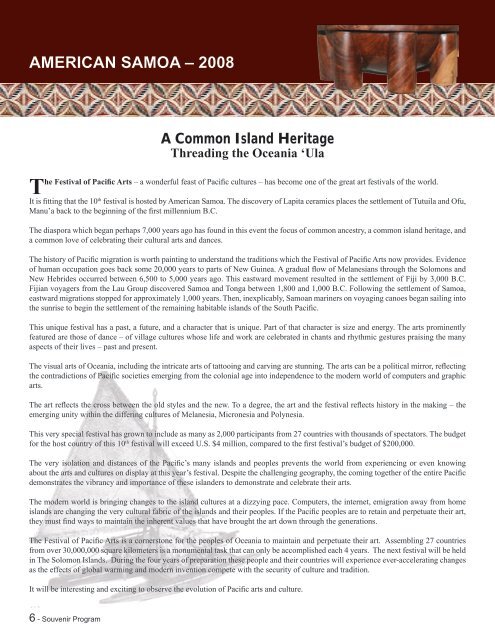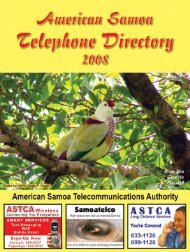10th Festival of Pacific Arts - American Samoa Information
10th Festival of Pacific Arts - American Samoa Information
10th Festival of Pacific Arts - American Samoa Information
You also want an ePaper? Increase the reach of your titles
YUMPU automatically turns print PDFs into web optimized ePapers that Google loves.
AMERICAN SAMOA – 2008<br />
6 - Souvenir Program<br />
A Common Island Heritage<br />
Threading the Oceania ‘Ula<br />
The <strong>Festival</strong> <strong>of</strong> <strong>Pacific</strong> <strong>Arts</strong> – a wonderful feast <strong>of</strong> <strong>Pacific</strong> cultures – has become one <strong>of</strong> the great art festivals <strong>of</strong> the world.<br />
It is fitting that the <strong>10th</strong> festival is hosted by <strong>American</strong> <strong>Samoa</strong>. The discovery <strong>of</strong> Lapita ceramics places the settlement <strong>of</strong> Tutuila and Ofu,<br />
Manu’a back to the beginning <strong>of</strong> the first millennium B.C.<br />
The diaspora which began perhaps 7,000 years ago has found in this event the focus <strong>of</strong> common ancestry, a common island heritage, and<br />
a common love <strong>of</strong> celebrating their cultural arts and dances.<br />
The history <strong>of</strong> <strong>Pacific</strong> migration is worth painting to understand the traditions which the <strong>Festival</strong> <strong>of</strong> <strong>Pacific</strong> <strong>Arts</strong> now provides. Evidence<br />
<strong>of</strong> human occupation goes back some 20,000 years to parts <strong>of</strong> New Guinea. A gradual flow <strong>of</strong> Melanesians through the Solomons and<br />
New Hebrides occurred between 6,500 to 5,000 years ago. This eastward movement resulted in the settlement <strong>of</strong> Fiji by 3,000 B.C.<br />
Fijian voyagers from the Lau Group discovered <strong>Samoa</strong> and Tonga between 1,800 and 1,000 B.C. Following the settlement <strong>of</strong> <strong>Samoa</strong>,<br />
eastward migrations stopped for approximately 1,000 years. Then, inexplicably, <strong>Samoa</strong>n mariners on voyaging canoes began sailing into<br />
the sunrise to begin the settlement <strong>of</strong> the remaining habitable islands <strong>of</strong> the South <strong>Pacific</strong>.<br />
This unique festival has a past, a future, and a character that is unique. Part <strong>of</strong> that character is size and energy. The arts prominently<br />
featured are those <strong>of</strong> dance – <strong>of</strong> village cultures whose life and work are celebrated in chants and rhythmic gestures praising the many<br />
aspects <strong>of</strong> their lives – past and present.<br />
The visual arts <strong>of</strong> Oceania, including the intricate arts <strong>of</strong> tattooing and carving are stunning. The arts can be a political mirror, reflecting<br />
the contradictions <strong>of</strong> <strong>Pacific</strong> societies emerging from the colonial age into independence to the modern world <strong>of</strong> computers and graphic<br />
arts.<br />
The art reflects the cross between the old styles and the new. To a degree, the art and the festival reflects history in the making – the<br />
emerging unity within the differing cultures <strong>of</strong> Melanesia, Micronesia and Polynesia.<br />
This very special festival has grown to include as many as 2,000 participants from 27 countries with thousands <strong>of</strong> spectators. The budget<br />
for the host country <strong>of</strong> this 10 th festival will exceed U.S. $4 million, compared to the first festival’s budget <strong>of</strong> $200,000.<br />
The very isolation and distances <strong>of</strong> the <strong>Pacific</strong>’s many islands and peoples prevents the world from experiencing or even knowing<br />
about the arts and cultures on display at this year’s festival. Despite the challenging geography, the coming together <strong>of</strong> the entire <strong>Pacific</strong><br />
demonstrates the vibrancy and importance <strong>of</strong> these islanders to demonstrate and celebrate their arts.<br />
The modern world is bringing changes to the island cultures at a dizzying pace. Computers, the internet, emigration away from home<br />
islands are changing the very cultural fabric <strong>of</strong> the islands and their peoples. If the <strong>Pacific</strong> peoples are to retain and perpetuate their art,<br />
they must find ways to maintain the inherent values that have brought the art down through the generations.<br />
The <strong>Festival</strong> <strong>of</strong> <strong>Pacific</strong> <strong>Arts</strong> is a cornerstone for the peoples <strong>of</strong> Oceania to maintain and perpetuate their art. Assembling 27 countries<br />
from over 30,000,000 square kilometers is a monumental task that can only be accomplished each 4 years. The next festival will be held<br />
in The Solomon Islands. During the four years <strong>of</strong> preparation these people and their countries will experience ever-accelerating changes<br />
as the effects <strong>of</strong> global warming and modern invention compete with the security <strong>of</strong> culture and tradition.<br />
It will be interesting and exciting to observe the evolution <strong>of</strong> <strong>Pacific</strong> arts and culture.



